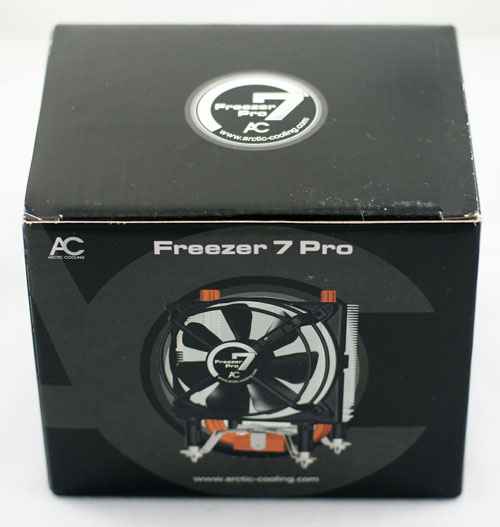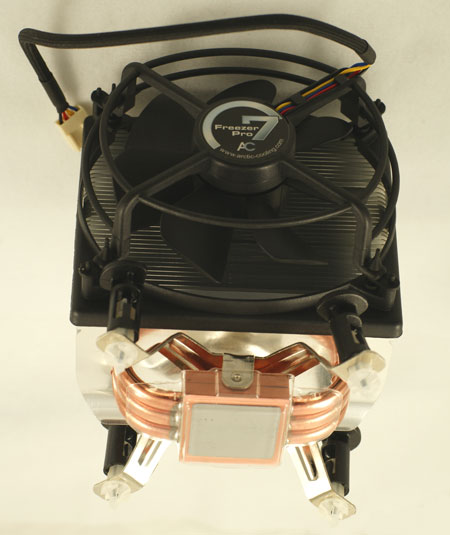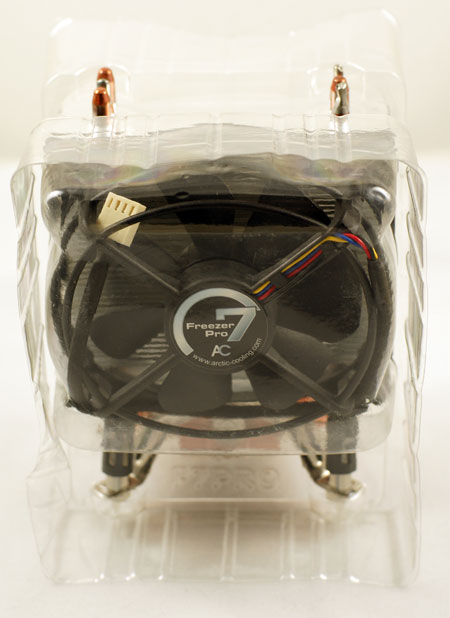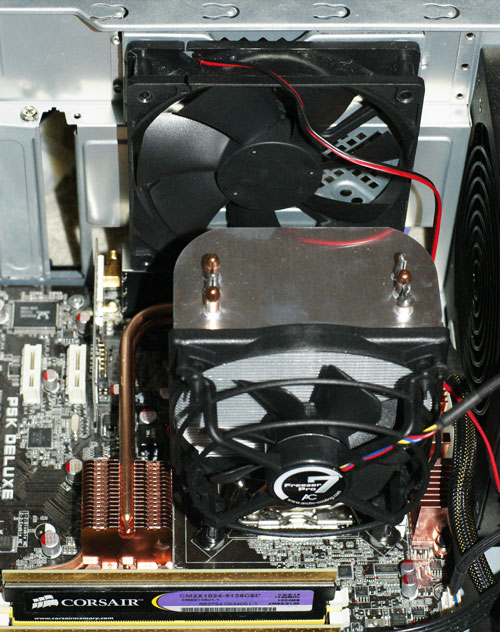Arctic Cooling Duo: Alpine 7 & Freezer 7 Pro Attack Value
by Wesley Fink on January 29, 2008 2:00 AM EST- Posted in
- Cases/Cooling/PSUs
Freezer 7 Pro
The tested Freezer 7 Pro is an Intel Socket 775 mount. The cooler is also available for current AMD sockets as the Freezer 64 Pro.

Packaging for the Freezer 7 Pro follows the family image of the Arctic 7 with a similar black background and the AC7 logo.

The fully assembled Freezer 7 Pro comes packaged in a protective styrene shell. Everything is pre-assembled. Even the thermal compound is pre-applied.

The only accessory for the Freezer 7 Pro is the Installation Instructions and an Arctic Cooling label to stick somewhere if you want to use it. There is absolutely nothing that needs to be attached to the cooler. If you like simple this is as good as it gets for a heatpipe tower.
Specifications
The Freezer 7 Pro is a side-facing fan heatpipe tower, similar in concept to many of the top coolers tested recently at AnandTech. It originally entered the market at around $35, but the price has dropped since to the $22 to $25 range, making it very affordable for this type of cooler. The Freezer 7 Pro is still small compared to coolers like our top Thermalrights, or the Scythe Infinity or Tuniq Tower. All those top coolers use 120mm fans, where the Freezer 7 Pro uses a 92mm fan.
| Freezer 7 Pro | |
| Heatsink Dimensions | 104(W) x 58(D) x 126.5mm(H) |
| Dimensions with Fan | 107(W) x 96.5(D) x 126.5mm(H) |
| Weight | 520g (18.3 ounces) |
| Material | Aluminum Fins with Copper Heatpipes |
| Cooling Capacity | 130W |
| Configuration | Heatpipe Tower with 3 U-Loop Heatpipes |
| Freezer Fan | |
| Fan Size | 92 mm |
| Fan Module Dimensions | 107mm x 43.5mm x 96mm |
| Fan Speed | 300-2500 rpm (controlled by pwm signal) |
| Connector | 4-pin (PWM) |
| Fan Bearing | Arctic Ceramic Bearing |
| Rated Life | 137,000 hours (MTTF@40C); 274,000 hours (MTTF@30) |
| Maximum Airflow | 46 CFM |
The Freezer 7 Pro fan itself is 92mm and frameless like the Alpine 7, but it is rated for higher output. Strangely, the higher output Freezer 7 Pro fan uses a lower life ceramic bearing instead of the long life Fluid Dynamic Bearing featured in the cheaper Alpine 7.
Installation

Even the thermal compound comes pre-applied so mounting is incredibly easy. Push the four pins in the holes until they click and the cooler is mounted. The pushpins are not our favorites for secure mounting, but they seem very adequate for this lighter weight heatpipe tower. Installation is the easiest we have ever seen, which should be welcome news for mechanically challenged cooler installers.










48 Comments
View All Comments
Etern205 - Tuesday, January 29, 2008 - link
Sorry for the triple post.Somehow the link code does not work so...
http://www.intel.com/cd/channel/reseller/emea/eng/...">http://www.intel.com/cd/channel/reselle...essors/c...
strikeback03 - Wednesday, January 30, 2008 - link
Great, an LED fan direct from Intel.and it still uses push pins, though since it weighs about the same as the previous stock cooler I guess that is expected.
sparkuss - Tuesday, January 29, 2008 - link
Is there any reason you don't include with the new testbed/database your custom water cooling setup that you've been using to chart the X38/X48?I realize it may be extreme but it feels missing if only to show what that "next" level of cooling means in relation to the "top rated performers". I guess I'd also be remiss in not asking for at least one of the new Peltier/Water compact combo coolers in the mix just for those reference lines on the graphs.
If you only want to limit results to "available/ready to buy" I understand.
I'm still looking at all options for my next "technology-leap" (AMD 4000+ 939) system build and being able to see if investing in the extreme is worth the results would help with some of the choices.
Thanks
strikeback03 - Wednesday, January 30, 2008 - link
I'd guess Wesley is in a different part of the country/world than Raja or whoever has the extreme cooling setup.mindless1 - Tuesday, January 29, 2008 - link
Quote:"low noise, longer-life fan bearings and elastomeric fan mounts. This is expensive engineering."These aren't really longer-life bearings. Anyone can make a bearing and claim that in an ideal environment it will have really long life. That's shady marketing, the finished fan, as implemented, is not that ideal environment for several reasons such as thrust level, imbalance, ambient temp. Frankly I find the bearing on my Freezer 64 Pro to be below average compared to my major (fan manufacturer not PC parts relabeler) brands. I would rate them as well if not better than many of the crude fans one would find on cheap heatsinks at least, and the fan imbalance being offset by the rubber mounts does help.
As for the elastomeric fan mounts, no this is not expensive engineering. Maybe a penny a piece, no more expensive than screws to hold a fan on. Perhaps we could say the unique fan frame design cost a slight bit extra though when in volume the cost may be less than you'd think, particularly if not manufactured by a major label. Upon examination of the fan bearing anyone with a trained eye can easily see these are not premium sleeve bearings by any stretch, and they are a lot short on lubricant, you should expect them not to be so quiet within the life of the system. Relube the bearing periodically for best results.
While my comments seem (are) negative, overall these coolers are a great value, but we do need to be objective in recognizing the cons as well as the pros. I'm not aware of better value for the money so they are still 'sinks to seriously consider except for attempts at extreme overclocking.
Wesley Fink - Tuesday, January 29, 2008 - link
The Engineering is expensive - not necessarily the parts. What we were trying to say here is that these kinds of solutions are usually reserved for higher-priced coolers, and not often seen on coolers selling for such a low price.As for bearing life, most coolers in this price range don't even rate fan bearing life. The expected "life" of the fan on the under $15 Alpine 7 is 400,000 hours and the bearing is a Fluid Dynamic Bearing - like the Scythe Sflex 120mm fan which is $20 for the fan alone. These are both impressive specs for any cooler fan - especially one that sells with the complete cooler for less than $15.
mindless1 - Tuesday, January 29, 2008 - link
The life rating of 400K hours is nonsense.Their typical fan sells for $6, and that with a bit of profit built in. Their bearings are not special, just the marketing is.
http://www.newegg.com/Product/Product.aspx?Item=N8...">http://www.newegg.com/Product/Product.aspx?Item=N8...
A minimum price is a better proof than an inflated one, as even the generic junk out there selling for $2 is also marked up 250% or more through relabelers.
forgotmypassword - Tuesday, January 29, 2008 - link
Your under load test is WAY TOO GENTLE. Same AC Freezer 7 can hardly keep my E6550 @ 2.8GHz Core Duo under 75C under 100% load... Compare it to your 41CRamarC - Tuesday, January 29, 2008 - link
if your e6550 is hitting 75c you either don't have the freezer 7 mounted properly or your bios/fan control is configured to allow that level of heat.mindless1 - Tuesday, January 29, 2008 - link
You have no evidence of that. A higher ambient temp, worse case ventilation, and/or higher vcore can cause this.However, some mountings don't seem to put as much pressure on the 'sink, it can be mounted as "properly" as possible and still this (and especially along with a combination of aforementioned factors) could result in that temp.
The real question is WHY someone would have allowed their CPU to get this hot instead of reducing the o'c or taking whatever other measures are necessary.